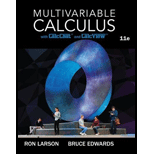
Converting to Polar Coordinates:
In Exercises 29–32, use polar coordinates to set up and evaluate the double
Want to see the full answer?
Check out a sample textbook solution
Chapter 14 Solutions
Multivariable Calculus
- Clairaut's Theorem Let DC R? be a disk containing the origin and assume that g : D→ R is a function given by g(x, y) = e" (cos y + x sin y). Prove that g(x, y) satisfies the Clairaut Theorem at point (0,0).arrow_forward-V2/2 4-x I 2 Vx2 + y² + 3 dy dx + 2 Vx2 + y² + 3 dy dx -V2 V2/2 J VI-x² Rewrite as an iterated double integral in polar coordinates and evaluate.arrow_forwardcalculate div(F) and curl(F). F = (xy, yz, y² – x³)arrow_forward
- Find the centroidarrow_forwardClairaut's Theorem Let DC R?be a disk containing the origin and assume g : D → R is a function given by that g(x,y) = e" (cos y + xsin y). Prove that g(x,y) satisfies the Clairaut Theorem at point (0,0).arrow_forwardconvert the region xy > 0 to polar coordinatesarrow_forward
- Vector F is mathematically defined as F = M x N, where M = p 2p² cos + 2p2 sind while N is a vector normal to the surface S. Determine F as well as the area of the plane perpendicular to F if surface S = 2xy + 3z.arrow_forwardClairaut's Theorem Let DCR be a disk containing the origin and assume that q : D → R is a function given by g(x, y) = e" (cos y +x sin y). Prove that g(x, y) satisfies the Clairaut Theorem at point (0, 0).arrow_forwardCalculus In Exercises 65-68, show that f and g are orthogonal in the inner product space C[a,b]with the inner product f,g=abf(x)g(x)dx. C[/2,/2], f(x)=cosx, g(x)=sinxarrow_forward
 Elementary Linear Algebra (MindTap Course List)AlgebraISBN:9781305658004Author:Ron LarsonPublisher:Cengage Learning
Elementary Linear Algebra (MindTap Course List)AlgebraISBN:9781305658004Author:Ron LarsonPublisher:Cengage Learning Trigonometry (MindTap Course List)TrigonometryISBN:9781337278461Author:Ron LarsonPublisher:Cengage LearningAlgebra & Trigonometry with Analytic GeometryAlgebraISBN:9781133382119Author:SwokowskiPublisher:Cengage
Trigonometry (MindTap Course List)TrigonometryISBN:9781337278461Author:Ron LarsonPublisher:Cengage LearningAlgebra & Trigonometry with Analytic GeometryAlgebraISBN:9781133382119Author:SwokowskiPublisher:Cengage


